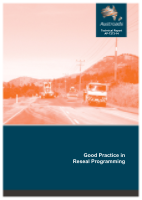Pavement

Good Practice in Reseal Programming
- Publication no: AP-T273-14
- ISBN: 978-1-925037-81-4
- Published: 19 September 2014
- PDF (free) Download
This report provides asset managers with practical guidance in the development and delivery of effective resealing programs. It builds on accumulated experience of previous studies and a review of sprayed seal performance throughout Australasia.
While an extensive body of sprayed seal knowledge and experience exists, there are significant issues which have serious consequences for the state and sustainability of road surfacings, and pavement assets, and ultimately their safe and efficient use. Examples of good practice do exist and road agencies are encouraged to review their procedures and the capabilities of their systems and human resources, with a view to adopting good practice and building capability.
- 1. Introduction
- 1.1. Background
- 1.2. Austroads Project AT1536
- 1.3. Scope and Objectives of the Project
- 1.4. Asset Management Principles
- 1.5. Legal Considerations
- 1.6. Structure and Contents of Report
- 2. Historical Practice and Previous Studies
- 2.1. General
- 2.2. Performance of Sprayed Seals
- 2.3. Factors Affecting Seal Life and Typical Treatments
- 2.3.1. Bearing Capacity or Structural Factors
- 2.3.2. Surface Disintegration
- 2.3.3. Skid Resistance
- 2.3.4. Reflected Damage
- 2.3.5. Treatment Selection
- 2.4. Seal Assessment
- 2.4.1. General
- 2.4.2. Evolution of Manual Rating Systems
- 2.4.3. Vehicle-mounted Systems
- 2.5. Time-series-based Field Performance Evidence
- 2.6. Origins and Justification of a ‘Stitch-in-time’
- 2.7. Risk Management and Legal Considerations
- 2.7.1. Background
- 2.7.2. Early Initiatives
- 2.7.3. Recent Guidance in Managing Civil Liability
- 2.7.4. Development of More Comprehensive Risk Management Procedures
- 2.8. Summary of Historical Practice and Performance
- 3. Findings and Outcomes from Review of Member Practices
- 3.1. General
- 3.2. Practice
- 3.2.1. General
- 3.2.2. Resealing Triggers
- 3.2.3. Resurfacing Rates
- 3.3. Practitioners’ Workshop
- 3.3.1. Development of a Sprayed Seal Program
- 3.3.2. Using Road Surface Condition Parameters/Inclusion Criteria
- 3.3.3. Establishing a Network-wide Program and Allocating Funding
- 3.4. Summary of Current Practice and Issues
- 4. Discussion and Way Forward
- 4.1. Key Issues and Current Initiatives
- 4.2. Continuous Improvement and Asset Management Maturity
- 5. Conclusions
- 5.1. Historical Practice and Previous Studies
- 5.2. Current Practice and Issues
- 5.3. Way Forward and Current Initiatives
- References
- Appendix A Development of a Seal Life Model for Australia
- Appendix B Development of VicRoads Surface Inspection Rating Procedure (SIRP)
- B.1 Background
- B.2 Evaluation Scale
- B.3 Potential Improvements
- Appendix C Developments in Reseal Assessment in Western Australia
- C.1 Case Study – Main Roads Western Australia (1)
- C.2 Case Study – Main Roads, Western Australia (2)
- Appendix D Development of a Pavement Risk Index in Queensland
- D.1 General Description
- D.2 Formulation of a Condition Index
- D.3 Value Judgement
- D.4 Transformation of the Physical Parameter to an Index
- D.5 Aggregation of Indices
Related publications
Latest Pavement News
